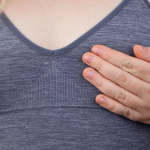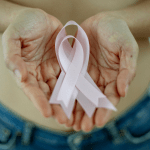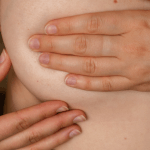Understanding Breast Pain and Its Prevalence
Breast pain, medically known as mastalgia, is a common symptom experienced by individuals across various stages of life. It manifests as tenderness, throbbing, or sharp pain in the breast tissue and can range from mild to severe. While it may occur occasionally, some experience it more persistently. Breast pain is not exclusive to women; men and transgender individuals can also be affected. The prevalence of breast pain is significant, with many experiencing it at some point in their lives. It is crucial to understand that while breast pain can be alarming, it is often not indicative of breast cancer.
Differentiating Between Cyclic and Noncyclic Breast Pain
Cyclic breast pain is closely related to the menstrual cycle, with symptoms intensifying in the lead-up to menstruation and easing afterwards. It typically affects both breasts, especially the upper, outer portions, and can radiate to the underarm. This type of pain is more common among individuals in their 20s and 30s, as well as those transitioning to menopause.
Noncyclic breast pain, on the other hand, does not follow a regular pattern and can be constant or intermittent. It often affects only one breast and may be localized or spread across the breast. This form of pain is more likely to occur after menopause.
Understanding the nature of breast pain is essential for management and treatment, as the approaches may differ based on the type of pain experienced.
The Importance of Consulting a Doctor for Persistent Pain
While breast pain is commonly benign, persistent or unexplained pain warrants medical attention. It is advisable to consult a healthcare professional if the pain continues daily for more than a couple of weeks, occurs in one specific area, worsens over time, disrupts daily activities, or awakens you from sleep. Although the risk of breast cancer is low for those whose main symptom is breast pain, following through with a doctor’s evaluation is important for peace of mind and proper management. A healthcare provider may recommend a clinical breast examination, mammogram, ultrasound, or biopsy to diagnose the cause of persistent breast pain accurately.
By the way, something for you, a little gift!!!
I am just in the middle of publishing my book. It’s about How women can balance their hormones. One part is about food and diet, of course.
Follow this link and enter your email.
I will send you this part of the book for free once the book is published. It has many concrete, practical tips and recipes and will help you feel better during menopause or times of Big hormonal fluctuations.
Annette, Damiva Lead for Health & Wellness

Dietary Adjustments for Managing Breast Pain
Benefits of a Low-Fat, High-Fiber Diet
One of the key strategies for managing breast pain is to make dietary adjustments, particularly adopting a low-fat, high-fiber diet. A diet rich in fats can exacerbate breast pain and may even increase the risk of breast cancer. Conversely, a diet that is low in fat and high in fiber can not only help in reducing breast pain but also contribute to overall health and longevity. Fiber-rich foods, such as fruits, vegetables, and whole grains, can help in maintaining a healthy weight and hormonal balance, which is crucial in managing cyclic breast pain associated with the menstrual cycle.
The Role of Caffeine Reduction
Another dietary consideration is the reduction of caffeine intake. Studies have suggested that women who reduce or eliminate caffeine from their diet report a decrease in breast pain. Caffeine is found in coffee, tea, chocolate, and some soft drinks, and it may contribute to breast tenderness, especially before a period. While the evidence is not conclusive, many women find relief by limiting these items in their diet. It’s worth experimenting with caffeine reduction to see if it alleviates breast pain.
Vitamin Supplementation: B6 and E
Vitamins play a crucial role in overall breast health, and certain vitamins have been shown to help reduce breast pain. Vitamin B6 is known for its role in the synthesis of neurotransmitters and can help in managing premenstrual symptoms, including breast tenderness. Vitamin E, on the other hand, is an antioxidant that protects the breast tissue from oxidative stress and free radical damage. Supplementation with these vitamins has been associated with a reduction in breast pain, making them a valuable addition to the diet of those experiencing mastalgia. However, it is important to consult with a healthcare provider before starting any new vitamin regimen to ensure it is appropriate for your individual health needs.
In conclusion, dietary adjustments such as embracing a low-fat, high-fiber diet, reducing caffeine consumption, and considering vitamin supplementation with B6 and E can be effective ways to manage breast pain. These changes not only target the symptom of breast tenderness but also promote a healthier lifestyle that can have far-reaching benefits for overall well-being.

From unhappy, dry, and sandpaper to silky, smooth and feeling good. That’s Cleo. Cleo is a 100% natural labial balm to moisture and soothe “your other lips”. Cleo is chemical-free, water-free, pH optimized and helps maintain and restore your delicate labial skin’s natural flora. Ideal for daily use or as needed. Get the most silky, lovable lips ever.
Natural Remedies and Supplements
Effectiveness of Evening Primrose Oil
Evening primrose oil is a well-known natural remedy for managing breast pain, also referred to as mastalgia. Extracted from the seeds of the evening primrose plant, this oil is rich in gamma-linolenic acid (GLA), an essential fatty acid. Some studies suggest that GLA can help correct imbalances in fatty acids within cells, potentially reducing the inflammation and pain associated with cyclic breast pain. Women have reported relief from the discomfort of mastalgia when using evening primrose oil, particularly for pain that fluctuates with the menstrual cycle.
While the evidence is promising, it’s important to note that results can vary, and evening primrose oil may not work for everyone. If considering this supplement, it’s recommended to consult with a healthcare provider, especially since dietary supplements can interact with other medications and have potential side effects.
Other Herbal and Natural Supplements
Beyond evening primrose oil, there are several other herbal and natural supplements that have been traditionally used to manage breast pain. Here are some that have garnered attention:
- Flaxseed: Containing omega-3 fatty acids, flaxseed may have anti-inflammatory properties that could help with breast pain. Ground flaxseed can be added to the diet to promote overall breast health.
- Vitamin E: Some early studies have indicated that vitamin E may benefit premenstrual women who experience fluctuating breast pain. However, it’s essential to adhere to recommended dosages to avoid potential side effects.
- Chaste Tree: Also known as Vitex agnus-castus, this herbal remedy has been used for various women’s health issues, including cyclic breast pain. It may help regulate hormonal imbalances that contribute to breast tenderness.
- Turmeric: Known for its anti-inflammatory properties, turmeric contains curcumin, which may help reduce inflammation and pain in breast tissue.
While these natural remedies can be helpful, they should be approached with caution and used under the supervision of a healthcare professional. It’s also crucial to maintain realistic expectations, as these supplements may offer relief but are not guaranteed cures. Additionally, keeping a journal to track the effectiveness of these remedies can be beneficial in determining what works best for an individual’s unique situation.
In conclusion, while natural remedies and supplements like evening primrose oil, flaxseed, vitamin E, and chaste tree may offer some relief from breast pain, it’s important to consult with a healthcare provider before starting any new supplement regimen. This ensures safety, especially for those with pre-existing health conditions or those taking other medications.
Proper Bra Fitting and Breast Support
How a Poorly Fitted Bra Can Cause Pain
Wearing a bra that doesn’t fit correctly is one of the most common contributors to breast discomfort and pain. A poorly fitted bra can lead to a variety of issues, including back, shoulder, chest, and neck pain. This is because an ill-fitting bra fails to provide adequate support to the heavy, fatty tissue in a woman’s breasts, causing them to move excessively throughout the day. Additionally, bras that are too tight can exert excessive pressure on the breasts, leading to sensitivity and discomfort. It’s important to note that 80 percent of women wear the wrong bra size, which can particularly affect those with larger breasts.
Tips for Selecting the Right Bra
Choosing the right bra is crucial for comfort and support. Here are some tips to ensure a good fit:
- The bra should feel comfortable and not cause any pain or discomfort.
- Ensure the back of the bra doesn’t ride up and stays horizontal across your back.
- Shoulder straps should be snug but not tight enough to dig into your skin.
- Your nipple line should be halfway between your shoulder and elbow.
- Check that your breasts are fully contained within the cups without any bulging.
- The band should be firm but not too tight, allowing you to slip a finger underneath easily.
- The center of the bra should sit close to your sternum.
- If the bra has underwire, it should lie flat against your body without digging in.
It’s recommended to get professionally measured at least once a year or after any significant change in weight, pregnancy, or breastfeeding. If you’re experiencing difficulty finding the right fit, consider visiting a specialty store for a personalized fitting.
The Importance of Sports Bras During Exercise
During physical activity, breasts can move in multiple directions, which can lead to pain and discomfort if not properly supported. A good-quality sports bra is essential as it is designed to reduce movement and provide support during exercise. Studies suggest that 60-70% of women report less breast pain when wearing a sports bra during physical activities. Sports bras are also recommended for wear during sleep if breast pain is disrupting rest. Remember to replace sports bras when they start to lose elasticity to ensure continuous support.
In conclusion, proper bra fitting and breast support play a significant role in managing breast pain and tenderness. By wearing a well-fitted bra and utilizing a sports bra during exercise, women can significantly reduce discomfort and support their breast health.

Popular Read
Timing Medical Exams with Your Menstrual Cycle
Scheduling Mammograms for Optimal Comfort
For many women, the thought of a mammogram brings a sense of discomfort and anxiety, particularly due to the breast compression involved in the procedure. However, timing your mammogram can play a significant role in minimizing discomfort. It is advisable to schedule your mammogram for the week following your menstrual period, when hormone levels have normalized, and breasts are less likely to be tender or swollen. This timing typically corresponds to about seven to 14 days after the onset of menstruation.
When scheduling your mammogram, communicate any concerns about pain to the scheduler. They may be able to allocate additional time for your appointment, allowing the technologist to take extra care in ensuring your comfort. If you have a history of chronic pain or a low pain threshold, mention this as well, so that accommodations can be made, such as having a technologist experienced in handling sensitive patients.
Understanding Breast Sensitivity During Menstrual Phases
Breast sensitivity fluctuates throughout the menstrual cycle due to hormonal changes. The luteal phase, which occurs after ovulation and before the start of menstruation, is when many women experience cyclic mastalgia. During this phase, high levels of estrogen and progesterone lead to the swelling of milk ducts and glands, resulting in breast pain and tenderness, particularly on the top and outer sides of the breasts.
Understanding these patterns can help you plan medical exams, such as mammograms, when your breasts are least likely to be sensitive. Avoid scheduling exams during the week before your period, when discomfort is at its peak. Instead, aim for the mid-cycle or the week after menstruation, when hormone levels are more stable, and breasts are less tender.
It’s also important to note that while cyclic breast pain is common and typically not a cause for concern, persistent or severe pain should be evaluated by a healthcare provider. Noncyclic breast pain, which is not related to the menstrual cycle, can have various causes and may require different management strategies.
In summary, by understanding the natural sensitivity of your breasts during different phases of your menstrual cycle, you can schedule medical exams, such as mammograms, at times when you’re likely to experience the least discomfort. This proactive approach can make necessary health screenings more bearable and less daunting.
Lifestyle Modifications to Alleviate Breast Pain
Limiting Sodium Intake to Reduce Fluid Retention
One of the key lifestyle changes that can help manage breast pain is limiting sodium intake. High levels of sodium in the diet can lead to fluid retention, which in turn can exacerbate breast tenderness, especially in the days leading up to a menstrual period. To reduce fluid retention, it is advisable to:
- Avoid processed foods, which often contain high levels of sodium.
- Read food labels carefully and choose products with lower sodium content.
- Enhance the flavor of meals with herbs and spices instead of salt.
- Consume plenty of water to help flush excess sodium from the body.
By adopting these dietary habits, not only can you alleviate breast pain, but you may also experience overall health benefits, such as reduced blood pressure and improved heart health.
Exercise and Stress Reduction Techniques
Regular exercise is another effective way to manage breast pain. Physical activity can improve circulation, reduce stress, and help maintain a healthy weight, which can all contribute to lessening breast discomfort. Consider incorporating the following into your routine:
- Aerobic exercises like walking, swimming, or cycling to promote overall well-being.
- Strength training to improve muscle tone and support breast tissue.
- Yoga or Pilates to enhance flexibility, posture, and stress relief.
It’s important to wear a supportive sports bra during exercise to prevent additional breast pain caused by movement.
In addition to physical exercise, stress reduction techniques can play a significant role in managing breast pain. High stress levels can affect hormonal balance, which may lead to increased breast tenderness. Techniques to reduce stress include:
- Mindfulness meditation to focus the mind and reduce anxiety.
- Deep breathing exercises to calm the nervous system.
- Progressive muscle relaxation to release tension in the body.
- Engaging in hobbies or activities that bring joy and relaxation.
By combining these lifestyle modifications, you can create a holistic approach to managing breast pain. Not only can these changes help reduce breast tenderness, but they can also contribute to a healthier, more balanced lifestyle.
Building a Supportive Healthcare Team
Communicating Effectively with Your Healthcare Providers
Effective communication with healthcare providers is crucial for managing breast pain. It’s important to be open and honest about your symptoms, concerns, and any changes you notice. Here are some tips for effective communication:
- Keep a symptom diary to track the frequency, intensity, and triggers of your breast pain. Share this with your healthcare team.
- Prepare for appointments by writing down questions and concerns in advance.
- Be clear about your expectations and what you hope to achieve from the consultation.
- Ask for clarification if medical terms or treatment plans are not understood.
- Discuss any dietary, lifestyle, or medication changes you’re considering to ensure they align with your treatment plan.
The Role of Each Team Member in Managing Breast Health
Your healthcare team may consist of various professionals who play different roles in managing breast health:
- Primary Care Physician (PCP): Your first point of contact for general health concerns, including initial assessment of breast pain.
- Gynecologist: Specializes in female reproductive health and can provide more targeted breast evaluations.
- Radiologist: An expert in imaging who can interpret mammograms and ultrasounds to diagnose underlying causes of breast pain.
- Nutritionist: Can offer guidance on dietary adjustments that may alleviate breast pain.
- Physical Therapist: Can suggest exercises and movements to strengthen the chest wall and improve posture, potentially reducing breast pain.
- Mental Health Professional: Can help address any psychological aspects, such as stress, that may exacerbate breast pain.
Patient Advocacy and Proactive Health Management
Being proactive in managing your health is key to living well with breast pain. This includes:
- Seeking regular medical exams and staying up-to-date with breast cancer screenings.
- Advocating for yourself by asking for second opinions or requesting referrals to specialists if needed.
- Staying informed about your condition and treatment options.
- Building a rapport with your healthcare team to ensure a collaborative approach to your care.
- Utilizing patient support services, such as support groups or educational workshops, to connect with others and learn more about managing breast pain.
Remember, you are the most important member of your healthcare team. Your active participation and willingness to manage your breast health can make a significant difference in your quality of life.









